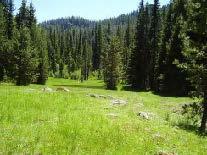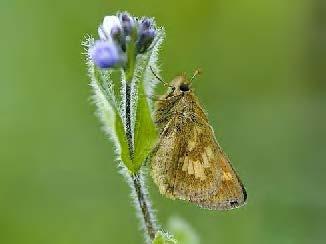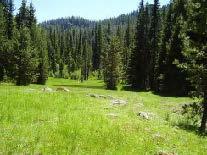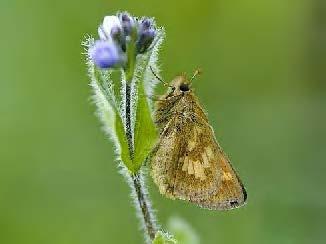Mardon Skipper (Polites mardon)
This article was originally published by the Washington Department of Fish and Wildlife as part of its annual report Threatened and Endangered Wildlife in Washington.
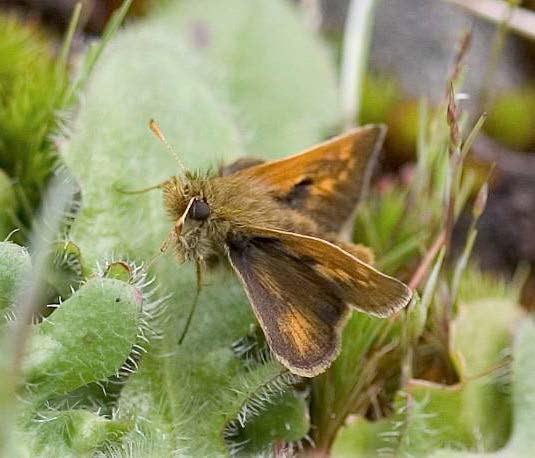
State status: Endangered, 1999
Federal status: Species of concern
Recovery plans: None
The Mardon skipper butterfly is a small (<1”), tawny-orange butterfly (Figure 1) dependent upon grassland habitats dominated by native grass species. Skippers are small butterflies that get their name from their fast erratic flight; they can be recognized because when perched, they hold their front and hind winds at different angles. The larvae of grass skippers in the subfamily Hesperiinae feed on grasses and sedges (Pyle 2002). Mardon skippers exist in four disjunct areas in Washington, Oregon and California. In Washington, the majority of sites are in the southern Cascades, but a few populations occur on south Puget Sound prairies.
Population status. In 1999, the Mardon skipper was known from a total of 14 sites in Washington, Oregon and California (Potter et al. 1999). By 2011, many additional sites had been discovered in Washington, primarily in the south Cascades (Table 1), while the number of occupied sites in the southern Puget Sound region was reduced to 4. Minimum abundance estimates in 2009 for the north and south units of Scatter Creek Wildlife Area were 84–360 and 399–1,286 individuals, respectively (Potter and Olson 2012). Populations are also patchily distributed in the Artillery Impact Area (AIA) at Joint Base Lewis-McChord and are roughly estimated to be 200-400 butterflies (Schultz et al. 2011).
The current known range in the Washington Cascades extends from the Rimrock Lake area along Highway 12 south to Glenwood and east to the Simcoe Mountains north of Goldendale. A total of 108 occupied sites were known from federal, tribal, and private lands in this portion of the state in 2011 (Table 1; USFWS 2012). Many of these sites have modest numbers of Mardon skippers (less than 50 individuals), and may be satellites of larger populations; a few host populations of hundreds, and at least two sites may support >1,000 individuals. Sites are typically isolated small meadows surrounded by miles of forest, with no apparent connectivity for dispersal between local populations (Kerwin and Huff 2007); skippers may not recolonize a site unless the distance between sites is less than 1 mi (USFWS 2010).
Habitat. In the south Puget Sound region, the species is found in open, glacial outwash grasslands with abundant Roemer’s fescue (Festuca roemeri) interspersed with early blue violet (Viola adunca) (Potter et al. 1999). On these prairies, adults feed on nectar from a variety of herbaceous plants. Early blue violet and common vetch (Vicia sativa) are strongly preferred as nectar sources and Scotch broom (Cytisus scoparius) is strongly avoided (Hays et al. 2000). Nectaring has also been observed on common camas (Camassia quamash), prairie lupine (Lupinus lepidus), fine-leaved desert parsley (Lomatium utriculatum), western buttercup (Ranunculus occidentalis), sea blush (Plectritis congesta), and yarrow (Achillea millefolium).
Plant species used by Mardon skippers for oviposition and larval food vary per location (Beyer 2009, Beyer and Schultz 2010). On South Puget prairies, Mardon skippers oviposit on Roemer’s fescue almost exclusively, indicating a strong association with this grass species (Henry 2010). In the Cascades, oviposition is known on 23 different plant species, but Mardon skippers are selective for certain grass species in different meadows (Beyer and Schultz 2010). The most frequently used oviposition plants include Idaho fescue (Festuca idahoensis), Kentucky bluegrass (Poa pratensis), timber oatgrass (Danthonia intermedia), long-stolen sedge (Carex inops), and red fescue (Festuca rubra). One-spiked oatgrass (Danthonia unispicta) appears to be an important grass species at sites on Wenatchee National Forest. Females have been observed ovipositing on this species (Henry 2010), and higher densities of adult butterflies are commonly associated with patches of D. unispicta (St. Hilaire et al. 2009). The variety of identified oviposition plants suggests that females may not always oviposit on specific host plants, but within a community of possible species that can be used by the larvae (Beyer and Black 2007).
Threats. Open grassland habitat in the south Puget Sound region has declined dramatically in the past 150 years due to agricultural and residential development, fire suppression, livestock grazing, and introduction of exotic plant species. Invasion by Scotch broom (Cytisus scoparius) and tall oatgrass (Arrhenatherum elatius) is a major threat. As a result of fire suppression, conifers have encroached into native grasslands, reducing both habitat for skippers and connectivity between grassland habitats. Management efforts to control invasive plants and maintain grasslands (prescribed fire, mowing, and herbicides), can also result in direct mortality of Mardon skippers. In the Cascades, intensive grazing is an ongoing issue at many Mardon skipper sites resulting in the loss of adult nectar sources, larval food plants, and presumably some direct mortality to butterfly larvae. Other threats include the unregulated use of off-road vehicles at several sites, pesticide applications (Btk), logging road construction, and military training and recreational activities in the south Puget Sound sites.
Current conservation actions. WDFW has been developing and testing survey methods to estimate numbers of Mardon skippers. Distance sampling has proven effective for monitoring the species at Scatter Creek Wildlife Area (Potter and Olson 2012). In 2012, WDFW continued research to understand oviposition habitat on Puget prairies; 27 oviposition locations were observed on JBLM and Scatter Creek (Beyer 2012).
WDFW is conducting intensive habitat restoration at the Scatter Creek Wildlife Area to protect and enhance Mardon skipper populations. Ongoing efforts include prescribed fire, direct seeding of native species, mowing, and herbicide control of Scotch broom and exotic grasses and forbs. WDFW is also restoring once-occupied habitat at West Rocky Prairie Wildlife Area, and is working with WDNR to restore and evaluate habitat at Mima Mounds Natural Area Preserve for reintroduction. Ongoing habitat management efforts are funded by grants from the Recreation and Conservation Office and Joint Base Lewis-McChord, Army Compatible Use Buffer program.
WDFW and the Oregon Zoo have been attempting to develop rearing methods for Mardon skippers that could be used to produce large numbers of skippers in captivity, but these efforts have not been successful to date (Schultz et al. 2011).
In 2012, the USFWS published a 12-month finding on a petition to list the Mardon skipper under the Endangered Species Act. They found listing was not warranted because the increased survey effort from 2000-2011 dramatically increased the number of known sites, predominantly on National Forests.
Partners and cooperators: Forest Service/BLM Interagency Special Status Species Program, U.S. Fish and Wildlife Service, Xerces Society, Center for Natural Lands Management, Recreation and Conservation Office, Joint Base Lewis-McChord, Gifford Pinchot National Forest, Wenatchee-Okanogan National Forest, Washington Department of Natural Resources, Oregon Zoo.
Beyer, L. 2009. Oviposition selection by a rare grass skipper, Polites mardon, in montane habitats: Advancing ecological understanding for developing conservation strategies. MS Thesis. Washington State University, Vancouver, Washington. 56 pp.
Beyer, L. 2012. Understanding Mardon Skipper Oviposition Habitat across the Puget Prairies: scaling up in time and space. Final Report. Washington Department of Fish and Wildlife. 29+xvii pp.
Beyer, L. and S. Hoffman Black. 2007. Site utilization by adults and larvae of Mardon skipper butterfly (Polites mardon) at four sites in Washington and Oregon. Final report to the Forest Service and BLM. 72 pp.
Beyer, L.J., and C.B. Schultz. 2010. Oviposition selection by a rare grass skipper Polites mardon in montane habitats: advancing ecological understanding to develop conservation strategies. Biological Conservation 143:862-872.
Hays, D.W., A. Potter, C. Thompson, and P. Dunn. 2000. Critical habitat components for four rare south Puget Sound butterflies. Washington Department of Fish and Wildlife, Olympia, and The Nature Conservancy, Washington, Seattle. 35 pp.
Henry, E.H. 2010. A first step towards successful habitat restoration and reintroduction: understanding oviposition site selection of an imperiled butterfly, Mardon skipper. M.S. thesis. Washington State University.
Kerwin, A. E., and R. Huff. 2007. Conservation assessment for the Mardon skipper (Polites mardon). Version 1.0. May, 2007. USDA Forest Service Region 6, Oregon and Washington. USDI Bureau of Land Management, Oregon and Washington. 42 pp.
Potter, A., J. Fleckenstein, S. Richardson, and D. Hays. 1999. Washington State status report for the Mardon skipper. Washington Department of Fish and Wildlife, Olympia, Washington. 39 pp.
Potter, A. and G. Olson. 2012. Monitoring Mardon skipper (Polites mardon) on the Scatter Creek Wildlife Area. Final Report (DRAFT). Report to Joint Base Lewis-McChord, ACUB Program. 47 pp.
Pyle, R. M. 2002. The Butterflies of Cascadia: a field guide to all the species of Washington, Oregon, and surrounding territories. Seattle Audubon Society, Seattle.
Schultz, C. B., E. Henry, A. Carleton, T. Hicks, R. Thomas, A. Potter, M. Collins, M. Linders, C. Fimbel, S. Black, H. E. Anderson, G. Diehl, S. Hamman, R. Gilbert, J. Foster, D. Hays, D. Wilderman, R. Davenport, E. Steel, N. Page, P. L. Lilley, J. Heron, N. Kroeker, C. Webb, and B. Reader. 2011. Conservation of prairie-oak butterflies in Oregon, Washington, and British Columbia. Northwest Science 85:361–388.
St. Hilaire, J., J. Bernatowicz, and W. Moore. 2009. U.S. Forest Service and Washington Department of Fish and Wildlife Mardon skipper (Polities mardon mardon). Report Naches Ranger District, Okanogan-Wenatchee National Forest, Spring and summer 2009. Unpublished agency report to USDA Forest Service and Washington Department of Fish and Wildlife, Naches, Washington. 24 pp.
USFWS (U.S. Fish and Wildlife Service). 2010. Species assessment and listing priority assignment form: Mardon Skipper. U.S. Fish and Wildlife Service, Portland, Oregon. 35 pp.
USFWS (U.S. Fish and Wildlife Service). 2012. 12-month finding on a petition to list the Mardon Skipper as Threatened or Endangered: proposed rule. Federal Register 77 (September 4,2012) No. 171:54332-54352.
Source: Washington Department of Fish and Wildlife. 2013. Threatened and Endangered Wildlife in Washington: 2012 Annual Report. Listing and Recovery Section, Wildlife Program, Washington Department of Fish and Wildlife, Olympia. 251 pp.



